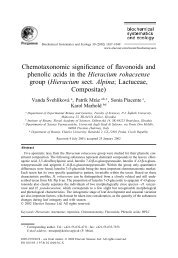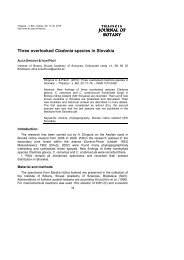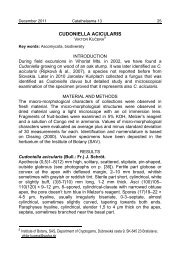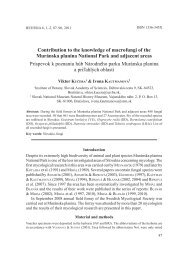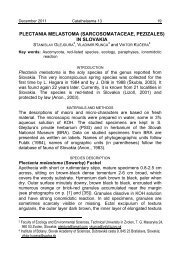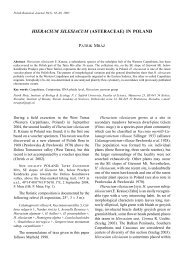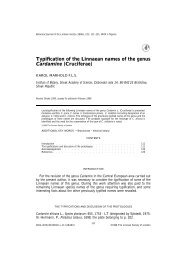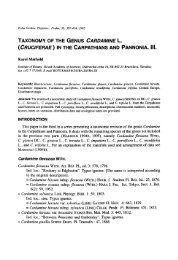Download pdf file - Institute of Botany SAS - SAV
Download pdf file - Institute of Botany SAS - SAV
Download pdf file - Institute of Botany SAS - SAV
Create successful ePaper yourself
Turn your PDF publications into a flip-book with our unique Google optimized e-Paper software.
Excursion guide III<br />
Devínska Kobyla and Sandberg National Nature Reserve and Protected Site<br />
Katarína Hegedüšová 1 , Dušan Senko 1 , Viera Feráková 1<br />
(1) <strong>Institute</strong> <strong>of</strong> <strong>Botany</strong>, Slovak Academy <strong>of</strong> Sciences, Dúbravská cesta 9, 845 23 Bratislava,<br />
Slovak Republic, e-mail: katarina.hegedusova@savba.sk, dusan.senko@savba.sk<br />
Geography<br />
The National Natural Reserve (NNR) Devínska Kobyla and the protected site Sandberg, a well<br />
known botanical, palaeontological and geological localities, are the southern-most parts <strong>of</strong> the<br />
Protected Landscape Area Malé Karpaty, called also Devínske Karpaty, located between the<br />
Morava and Danube rivers, where the Carpathian Mountains meet with the Pannonian Basin. The<br />
Slovak-Austrian border, the municipal parts <strong>of</strong> Bratislava, former villages Devínska Nová Ves
and Devín, surround it also. This unique geographical position resulted in the extraordinary<br />
physical-geographical conditions, such as topography and climate, with specific, rare and rich<br />
species steppe flora and fauna. From a morphometrical point <strong>of</strong> view Devínska Kobyla has an<br />
approximately symmetrical shape and is distinctive by its peripheral slopes, with slope angle<br />
ranging from 25 to 30°, and by vaulted central part where slope angles range from 10 to 15°. Its<br />
elevation ranges from 135 at the Danube, and Morava floodplain, to 514 m, at its highest point.<br />
The altitudinal difference between the Morava River (135 m) and the top <strong>of</strong> Devínska Kobyla<br />
Hill (514 m) is 379 m. Total area <strong>of</strong> reservation is 114.38 ha and it represents one <strong>of</strong> the<br />
NATURA 2000 sites and also Important Plant Area (IPA). It is located about 10 km from centre<br />
<strong>of</strong> Bratislava, capital city <strong>of</strong> Slovakia. The unique area <strong>of</strong> the instructive path is maximum 2880<br />
m long and 825 m width, with plenty <strong>of</strong> natural details to look at and the breathtaking<br />
panoramathic view <strong>of</strong> the confluence <strong>of</strong> the Danube and Morava rivers, the Devín castle and the<br />
Austrian Hainburg hills. In good weather conditions even the Alps may be visible.<br />
Geology and paleontology<br />
In term <strong>of</strong> geology, Devínska Kobyla represents a very interesting territory “a treasure <strong>of</strong><br />
geological processes”, remarkable especially for its Neogene fauna from the surrounding <strong>of</strong><br />
Devínska Nová Ves village. About 300 million years ago the mountain was part <strong>of</strong> the precontinent<br />
Pangea. Several times subsequently the area was covered by the sea and during this<br />
period limestone and dolomite were formed (found in Devínska hradná skala rock, Weitov lom<br />
quarry). The unique range <strong>of</strong> the Carpathians begins by the Devín castle rock on the confluence<br />
<strong>of</strong> two rivers Dunaj and Morava. Southern slopes <strong>of</strong> the NNR are created mainly by grey<br />
limestones, dolomites and carbonate breccia, the strata are 160-180 million years old. The top <strong>of</strong><br />
the hill Devínska Kobyla with the same name, which is not part <strong>of</strong> the reserve, is formed by<br />
Mesozoic quartzite. The territory <strong>of</strong> the sand pit Sandberg represents a stratotype locality for<br />
stratigraphical sub-stage called “devín”, which was discovered because <strong>of</strong> sand mining. Rock
emains <strong>of</strong> Neogene Sea that covered the Vienna basin create its area. It is also a Neogene<br />
paleontological locality <strong>of</strong> European importance. More than 300 species <strong>of</strong> fossil organisms<br />
(algae, fungi, marine invertebrates and vertebrates, especially mammals) are known from there.<br />
With regard to the terrestrial ones, rare findings <strong>of</strong> primates Sivapithecus sp., occurs only in this<br />
locality within Slovakia (Feráková et al. 1997, Hegedüšová 2009).<br />
Soils<br />
The prevailing soil types on shallow and dry places are Eutric Cambisols developed on the<br />
Mesozoic quartzite and on diluvia <strong>of</strong> carbonate-silicate deposits. They are mostly covered with<br />
oak-hornbeam forests. Rendzic Leptosols are developed on limestones and dolomites covered<br />
mainly with dry grasslands and open Mediterranean xero-thermophilous oak forests. Regosols<br />
and sands are less frequent (Sandberg, Merice) developed on sandstones (Bedrna 1997).<br />
Climate<br />
The climate <strong>of</strong> the NNR Devínska Kobyla is sub-continental, summer-warm, moderate dry with<br />
mild winter (Holec 1997). The extra warm and dry climate is characteristic for sun-exposed,<br />
south-western steep slopes. The mean annual temperature is 9° C, with maximum temperature<br />
32.8° C and minimum temperature –15.5° C. The mean annual precipitation is 604.9 mm. <strong>of</strong><br />
which 360,1 mm falls in the vegetation season (March, September). Monthly rain sums vary<br />
considerably between the years, and long periods <strong>of</strong> drought are common (in 2003). This type <strong>of</strong><br />
climate supports the development <strong>of</strong> forest-steppe vegetation.<br />
Landscape history and nature conservation<br />
Due to its favourable geographical location and climatic conditions Devínska Kobyla and its<br />
surrounding was one <strong>of</strong> the first parts <strong>of</strong> Slovakia to be inhabited (Viceníková et al. 2002).<br />
Neolithic people built the first dwellings in this area on the left side <strong>of</strong> the riverbank Dunaj<br />
between 5000 and 3500 BC. The strategic position <strong>of</strong> this place, the cliff (altitude <strong>of</strong> 212 m) at<br />
the confluence <strong>of</strong> the Dunaj and Morava was an ideal place for a fort. Its owner could control the<br />
famous trade route along the Danube as well as one branch <strong>of</strong> the Amber Road. That is why the<br />
site had become a strategic military post in the time <strong>of</strong> the Bronze and Iron Age (900 BC). In the<br />
Younger Iron Age, the territory was populated with Celts, which started to cut down the trees. At<br />
the times <strong>of</strong> the Roman Empire, Devin was still an important military station. In that period the<br />
Romans started growing wine grape in vineyards on the Devínska Kobyla hills. Devín fortress<br />
was first mentioned in the documents from 864 AD under the name Dowina. During the Greater<br />
Moravian Empire (9th century), the castle was a significant boundary fortress as well as one <strong>of</strong><br />
the political and administrative centres. Two Slavonic fortresses (Sandberg and quarry) were built<br />
on the hillsides <strong>of</strong> Devínska Kobyla to protect the kingdom <strong>of</strong> prince Rastislav. After the fall <strong>of</strong><br />
the Greater Moravian Empire, the castle served as a boundary castle <strong>of</strong> the Hungarian state. It<br />
witnessed also invasion <strong>of</strong> Turkish armies, German and Croatian colonisation (Devínska Nová<br />
Ves village). In 1809, the castle was destroyed by the by Napoleonic troops. Since 1965<br />
archaeological research in the castle area and partial reconstruction <strong>of</strong> the ruins have been made.<br />
Devínska Kobyla is included nowadays in the Protected Landscape Area Malé Karpaty Mts.<br />
(PLA). It was proposed as an Important Plant Area with total area <strong>of</strong> 127 ha in 2004. The NNR<br />
Devínska Kobyla was originally established as two separate reserves, the first one Sandberg in<br />
1964 and the State Nature Reserve Devínska Kobyla on SW slopes with thermophilous<br />
vegetation (27.97 ha) in 1965. Both reserves were united in 1986 and the part Merice above
Devín village was added. This area is under the fifth level <strong>of</strong> nature protection (the highest<br />
possible in Slovakia). A nature trail across the western slope was opened in 1988 and renewed in<br />
2000.<br />
Vegetation, flora and fauna<br />
The typical feature <strong>of</strong> Devínska Kobyla and Sandberg is a high flora and also fauna biodiversity,<br />
due to the unique position, the heterogeneity <strong>of</strong> its geological substratum, the specific climatic<br />
conditions, the human influence and the vicinity <strong>of</strong> the Malé Karpaty Mts. The original<br />
vegetation was formed by oak-hornbeam forests, xero-thermophilous oak forests with Quercus<br />
pubescens on steep slopes with a limestone base and rocky grasslands, which are conserved in<br />
spite <strong>of</strong> human influence (vineyards, orchards, grazing, burning <strong>of</strong> grasslands, afforestation by<br />
non-native trees e.g. Pinus nigra, Fraxinus ornus). Since 1949, a continuous area <strong>of</strong> xerothermophilous<br />
pastures (at the time 85.8 % <strong>of</strong> the total area) has been greatly fragmented into the<br />
present mosaic vegetation <strong>of</strong> rocky and dry grasslands (33.4 %) – steppe communities along with<br />
sub-Mediterranean xero-thermophilous oak woods Corno-Quercetum and Pruno mahaleb-<br />
Quercetum pubescentis. Among the trees on the south-western slopes we can find Cerasus<br />
fruticosa, C. mahaleb, Cornus mas, Quercus pubescens, Q. cerris and Ulmus minor. Altogether<br />
the forests communities cover now 50.7 % <strong>of</strong> the NNR. On the northern slopes beech forests as<br />
Melico uniflorae-Fagetum and fragments <strong>of</strong> Carici pilosae- Fagetum and Carici albae-Fagetum<br />
are developed. Fagus sylvatica reaches here the lowest altitudes in the Western Carpathians Mts.<br />
On screes there are stands with Tilia cordata and Acer campestre, which belong to the alliance<br />
Tilio-Acerion. The most frequently occurring community in the NNR is Carici pilosae-<br />
Carpinetum with characteristic spring aspect created by Galanthus nivalis, later replaced by<br />
Hepatica nobilis, Corydalis cava and Anemone ranunculoides. Among non-native trees Robinia<br />
pseudoacacia and Syringa vulgaris are the most common. The continuous human impact on the<br />
area has increased the diversity <strong>of</strong> plant species. Cutting down and burning the woods created<br />
more space for plant species and communities that are typical <strong>of</strong> rocky areas. In<br />
phytosociological terms they belong to the class <strong>of</strong> Euro-Siberian steppes, Festuco-Brometea.<br />
The prevailing vegetation types <strong>of</strong> the xero-thermophilous grasslands communities are Poo<br />
badensis-Festucetum pallentis, Festuco pallentis-Caricetum humilis, Festuco valesiacae-<br />
Stipetum capillatae, Polygalo majoris-Brachypodietum pinnati and Pannonian fringe vegetation<br />
Geranio sanguinei-Dictamnetum albae and Peucedanetum cervariae. The stands <strong>of</strong> Festuco<br />
valesiacae-Stipetum capillatae (alliance Festucion valesiacae) represent a type <strong>of</strong> continental<br />
steppe. These communities were traditionally maintained by extensive grazing, mowing and<br />
burning.<br />
According to the phytogeographical division <strong>of</strong> Slovakia (Futák 1984), Devínska Kobyla is<br />
situated on the border <strong>of</strong> two phytogeographical regions: the region <strong>of</strong> Pannonian flora and the<br />
region <strong>of</strong> West Carpathian flora. Finally it belongs to the region Eupannonicum with close<br />
phytogeographic relationship to the Hundsheimer hills in Austria. In Devínska Kobyla we can<br />
find Western Carpathian, Pannonian and Mediterranean species growing together, and reaching<br />
the most western or northern boundaries <strong>of</strong> their natural occurrence. In the species composition <strong>of</strong><br />
vegetation xero-thermophilous and calciphilous elements dominate. Altogether, more than 1500<br />
vascular plant species and subspecies including adventive taxa (Feráková et Hodálová unpubl.)<br />
were recorded here. All communities host a high number <strong>of</strong> endangered and rare species. 376 are<br />
threatened and 33 <strong>of</strong> them categorized as critically endangered (CR), endangered (EN) and<br />
vulnerable (VU), as well as 10 species in the category extinct (EX) are included in the Red Data<br />
Book, Vol. 5 <strong>of</strong> the Slovak and Czech Republics (Čeřovký et al., 1999). Species such as
Conringia austriaca, Ononis pussila, Orobanche artemisiae-campestris, O. teucrii, Peucedanum<br />
arenarium and on the limestone rocks Rhamnus saxatilis subsp. saxatilis were recorded here and<br />
nowhere else in Slovakia. Gypsophila paniculata is on the verge <strong>of</strong> extinction. A famous spring<br />
aspect is created by Adonis vernalis, Pulsatilla pratensis subsp. bohemica and P. grandis, later<br />
joined by Iris pumila in three colour tones – purple, yellow and white. The rare orchids<br />
Anacamptis pyramidalis, Ophrys apifera, O. holoserica, O. insectifera, O. sphegodes, Orchis<br />
morio, O. tridentata subsp. tridentata, O. ustulata subsp. ustulata bloom in May together with<br />
Stipa grasses. On the steep slopes and open sands with the shallowest substratum colline<br />
calcareous grasslands can be found. The dominating Festuca pallens is accompanied by Fumana<br />
procumbens, Linum tenuifolium, Potentilla arenaria and Scorzonera austriaca. On the gentle<br />
slopes Carex humilis is dominant with numerous chamaephytes and ephemeral therophytes such<br />
as Allysum montanum, Globularia punctata, Helianthemum nummularium, Jurinea mollis,<br />
Thymus praecox, Teucrium montanum and T. chamaedrys. On the rocky and moderately deep<br />
soils Stipa capillata and Festuca valesiaca stands are developed. The extra-zonal vegetation is<br />
represented by Pannonian fringe vegetation with common species Geranium sanguineum,<br />
Dictamnus albus, Cyanus triumfettii, Anemone sylvestris and Tephroseris integrifolia. In those<br />
parts <strong>of</strong> the forests that are more exposed to sunlight it is possible to find the originally<br />
Mediterranean species Smyrnium perfoliaum, which was rare in the past and is quickly spreading<br />
nowadays. An important feature <strong>of</strong> the floristic composition <strong>of</strong> the NNR is occurrence <strong>of</strong> various<br />
species and hybrids <strong>of</strong> the genus Viola. The area <strong>of</strong> the NNR is important also because <strong>of</strong><br />
diversity <strong>of</strong> cryptogams: 110 lichen species, 100 bryophyte species and 331 fungi have been<br />
recorded.<br />
From the zoological point <strong>of</strong> view Devínska Kobyla is one <strong>of</strong> the places with the highest<br />
biodiversity in Slovakia. According to the zoogeographical classification <strong>of</strong> terrestrial bio-cycle<br />
<strong>of</strong> Slovakia (Jedlička & Kalivodová 2002), the area <strong>of</strong> the NNR belongs to the region <strong>of</strong> West<br />
Carpathians, province <strong>of</strong> Pannonian steppe, part Devínska Kobyla Mts., on a border <strong>of</strong> region <strong>of</strong><br />
deciduous forests and steppes. It is particularly characterized by a high abundance <strong>of</strong><br />
thermophilous and xerophilous species <strong>of</strong> insects, which create unique zoological communities.<br />
A lot <strong>of</strong> species reach the most northern boundary <strong>of</strong> their natural occurrence. A many species are<br />
rare, such as insect Mantispa styriaca, beetles Lucanus cervus, Oryctes nasicornis, Rosalia<br />
alpina and butterflies Zanclegnatha tarsicristalis, Yponemeuta vigintipunctatus and Procris<br />
gerryon. Xerothermic species including cicadas (Tibicina haematodes), crickets (Gryllus<br />
desertus), neuroptera (Ascalaphus macaronius), spiders (Eresus cinnaberinus), grasshoppers<br />
(Saga pedo) and Mantis religiosa contribute to the exotic atmosphere. Mantis religiosa, with two<br />
coloured varieties, is the only representative <strong>of</strong> Mantodae. A lot <strong>of</strong> them are protected and<br />
endangered, e.g. Papilio machaon, Iphiclides podalirius, Ascalaphus macaronius, Lucanus<br />
cervus, Parnassius mnemosine. On the open sandy places Meloe violaceus is also frequent.<br />
Altogether, 44 species <strong>of</strong> the terrestrial gastropods were found here. The most abundant are<br />
Granaria frumentum, Balea biplicata and Truncatellina cylindrical. The amphibians are<br />
represented by Bufo bufo, Bufo viridis and Salamandra salamandra. In the southern slopes<br />
emerald coloured <strong>of</strong> male lizard Lacerta viridis can be frequently seen. From the reptiles there<br />
are also Anguis fragilis, Natrix natrix and N. tesselata. The deciduous forests are the home <strong>of</strong><br />
Elaphe longissima, the biggest snake in Slovakia. The endangered bird species, which nest here,<br />
are Corvus corax, Falco subbuteo, Tichodroma muraria and Upupa epops. The sandstone walls<br />
<strong>of</strong> Sandberg are attractive with the appearance <strong>of</strong> European bee-eaters Merops apiaster.<br />
Mammals are not as strongly represented as other animal groups. Among the typical
epresentative <strong>of</strong> rodents (Rodentia) are Sciurus vulgaris, Microtus arvalis and Glis glis.<br />
Lagomorpha represents Lepus europaeus. Typical representatives <strong>of</strong> Carnivora are Meles meles<br />
and Vulpes vulpes. Artiodactyla are here represent by Capreolus capreolus and Sus scr<strong>of</strong>a.<br />
Threats<br />
The present state <strong>of</strong> vegetation on the Devínska Kobyla NNR is conditioned predominantly by<br />
succession (Hegedüšová 2009). The xero-thermophilous grassland vegetation is strongly<br />
threatened by changes in management, and soil conditions, the first <strong>of</strong> all by abandonment <strong>of</strong> the<br />
traditional use <strong>of</strong> the landscape and an inappropriate human intervention. During the state<br />
afforestation programme many non-native species were planted, mostly Pinus nigra further<br />
Prunus serotina and Aesculus hippocastanum. Obscuration and needles cast, which changes pH<br />
<strong>of</strong> soils, are liable for the treat <strong>of</strong> many rare endangered species. Big problems are especially soil<br />
erosion caused by cyclists who ride on the sensitive south-western slopes and construction <strong>of</strong> new<br />
open fires. The absence <strong>of</strong> grazing, meadow cutting, and burning resulted in spreading <strong>of</strong><br />
competitively strong grasses such as Bromus erectus, Arrhenatherum elatius and shrubs<br />
Crataegus sp., Rosa sp. div. and Prunus spinosa. The diversity <strong>of</strong> the plant communities was<br />
declining and many species disappeared. Another big problem is represented by non-native plant<br />
species, which grow in surrounding <strong>of</strong> gardens, spread to the protected area and make it difficult<br />
for native species to survive.<br />
The nomenclature <strong>of</strong> vascular plants follows Marhold & Hindák (1998). The nomenclature <strong>of</strong><br />
syntaxa has been unified according to Janišová et al. (2007).<br />
Acknowledgement<br />
The authors are grateful to Paolo Zuccarini for his correction <strong>of</strong> English. The research was<br />
financially supported by the grant SK 0115 through the EEA Financial Mechanism and the<br />
Norwegian Financial Mechanism, VEGA 2/0181/09).<br />
References<br />
Bedrna Z. (1997): Pôdy Národnej prírodnej rezervácie Devínska Kobyla. – In: Feráková V. (ed.), Flóra,<br />
geológia a paleontológia Devínskej Kobyly [Flora, geology and paleontology <strong>of</strong> Devínska Kobyla.]<br />
APOP, Bratislava, 190 pp.<br />
Čeřovský J., Feráková V., Holub J., Maglocký Š. (1991): Červená kniha ohrozených a vzácnych druhov<br />
rastlín a živočíchov SR a ČR Vol. 5. Vyššie rastliny. Príroda, Bratislava, 456pp.<br />
Feráková V. et al. (1997): Flóra, geológia a paleontológia Devínskej Kobyly [Flora, geology and<br />
paleontology <strong>of</strong> Devínska Kobyla. In Slovak with English summary.] Apop, Bratislava, 190 pp.<br />
Feráková V., Maglocký Š., Marhold K. (2001): Červený zoznam papraďorastov a semenných rastlín<br />
Slovenska (december 2001). [Red list <strong>of</strong> ferns and vascular plants <strong>of</strong> Slovakia. In Slovak with English<br />
abstract.] In: Baláž D., Marhold K., Urban P. (eds.), Červený zoznam rastlín a živočíchov Slovenska.<br />
Ochrana prírody, 20 (Suppl.): 44-77, Banská Bystrica.<br />
Futák J. (1984): Fytogeografické členenie 1: 1 000 000. – In: Bertová L. (ed.), Flóra Slovenska IV/1. Veda<br />
<strong>SAV</strong>, Bratislava, pp. 418-420.<br />
Hegedüšová K. (2009): Devínska Kobyla and Sandberg – National Nature Reserve (Slovak Republic). In:<br />
Remarkable dry grassland type/site, Bull. Eur. Dry Grassland Group, Hamburg, Germany, 3 (June<br />
2009), ISSN 1868-2456, http://www.edgg.org/publications.htm.
Holec P. (1997): Klimatické pomery. – In: Feráková V. (ed.), Flóra, geológia a paleontológia Devínskej<br />
Kobyly [Flora, geology and paleontology <strong>of</strong> Devínska Kobyla.] APOP, Bratislava, 190 pp.<br />
Janišová M. (ed.) (2007): Grassland vegetation <strong>of</strong> Slovak Republic – electronic expert system for<br />
identification <strong>of</strong> syntaxa. Bratislava. <strong>Institute</strong> <strong>of</strong> <strong>Botany</strong> <strong>SAS</strong>, 265 pp.<br />
Jedlička L., Kalivodová E. (2002): Zoogeografické členenie: terestrický biocyklus. In: Atlas krajiny<br />
Slovenskej republiky. Bratislava: Ministerstvo životného prostredia SR; Banská Bystrica: Slovenská<br />
agentúra životného prostredia, p. 118.<br />
Marhold K., Hindák F. (eds.) (1998): Zoznam nižších a vyšších rastlín Slovenska. Veda <strong>SAV</strong>, Bratislava,<br />
688 pp.<br />
Viceníková A., Kočvara V., Zlochová K. (2002): Hiking on Devínska Kobyla. Daphne, Bratislava.<br />
Appendix 1. Short list <strong>of</strong> Vascular plants <strong>of</strong> the National Nature Reserve Devínska Kobyla<br />
Acer campestre<br />
Acer platanoides<br />
Acer pseudoplatanus<br />
Acinos arvensis<br />
Adonis vernalis<br />
Agrimonia eupatoria<br />
Agrostis capillaris<br />
Achillea collina<br />
Achillea millefolium agg.<br />
Achillea pannonica<br />
Achillea setacea<br />
Alliaria petiolata<br />
Allium flavum<br />
Allium senescens subsp. montanum<br />
Alyssum montanum<br />
Anacamptis pyramidalis<br />
Anemone sylvestris<br />
Anthericum ramosum<br />
Anthyllis vulneraria<br />
Arabidopsis thaliana<br />
Arabis hirsuta<br />
Arabis turrita<br />
Arenaria serpyllifolia agg.<br />
Arrhenatherum elatius<br />
Artemisia absinthium<br />
Artemisia campestris<br />
Asparagus <strong>of</strong>ficinalis<br />
Asperula cynanchica<br />
Asperula tinctoria<br />
Aster amelloides<br />
Astragalus onobrychis<br />
Avenula pratensis<br />
Berberis vulgaris<br />
Betonica <strong>of</strong>ficinalis<br />
Bothriochloa ischaemum<br />
Brachypodium pinnatum<br />
Brachypodium sylvaticum<br />
Briza media<br />
Bromus erectus<br />
Bromus hordeaceus<br />
Bupleurum falcatum<br />
Camelina microcarpa<br />
Campanula bononiensis<br />
Campanula glomerata<br />
Campanula rotundifolia<br />
Campanula sibirica<br />
Cerasus vulgaris<br />
Cerasus fruticosa<br />
Cerasus mahaleb<br />
Carex alba<br />
Carex caryophyllea<br />
Carex hirta<br />
Carex humilis<br />
Carex michelii<br />
Carex pilosa<br />
Carlina acaulis<br />
Carlina vulgaris<br />
Carpinus betulus<br />
Centaurea stoebe s.lat.<br />
Centaurea triumfettii<br />
Cerastium arvense<br />
Cerastium brachypetalum<br />
Cerastium glomeratum<br />
Cerastium glutinosum<br />
Cerastium semidecandrum<br />
Clematis recta
Colymbada scabiosa<br />
Conringia austriaca<br />
Convallaria majalis<br />
Conyza canadensis<br />
Cornus mas<br />
Corydalis cava<br />
Corydalis pumila<br />
Corydalis solida<br />
Corylus avellana<br />
Cotoneaster integerrimus<br />
Cotoneaster tomentosus<br />
Crataegus laevigata<br />
Crataegus monogyna<br />
Crinitina linosyris<br />
Cruciata glabra<br />
Cuscuta species<br />
Cyanus triumfetti<br />
Cynodon dactylon<br />
Dactylis glomerata<br />
Daucus carota<br />
Dianthus deltoides<br />
Dianthus pontederae<br />
Dictamnus albus<br />
Dorycnium herbaceum<br />
Echium vulgare<br />
Elytrigia intermedia<br />
Erophila verna<br />
Eryngium campestre<br />
Erysimum diffusum agg.<br />
Erysimum odoratum<br />
Euonymus europaeus<br />
Euonymus verrucosus<br />
Fagus sylvatica<br />
Falcaria vulgaris<br />
Fallopia convolvulus<br />
Festuca pallens subsp. pallens<br />
Festuca pratensis agg.<br />
Festuca rubra<br />
Festuca rupicola<br />
Festuca valesiaca<br />
Fragaria vesca<br />
Fragaria viridis<br />
Fraxinus excelsior<br />
Fraxinus ornus<br />
Fumana procumbens<br />
Galanthus nivalis<br />
Galeobdolon luteum<br />
Galium glaucum<br />
Galium odoratum<br />
Galium pycnotrichum<br />
Galium verum<br />
Genista germanica<br />
Genista pilosa<br />
Genista tinctoria<br />
Geranium sanguineum<br />
Geranium sylvaticum<br />
Geum urbanum<br />
Glechoma hederacea<br />
Globularia punctata<br />
Grammica campestris<br />
Gypsophila paniculata<br />
Hedera helix<br />
Helianthemum grandiflorum<br />
Helianthemum grandiflorum subsp.<br />
obscurum<br />
Helichrysum arenarium<br />
Hepatica nobilis<br />
Heracleum sphondylium<br />
Hesperis tristis<br />
Hieracium sabaudum<br />
Himantoglossum adriaticum<br />
Holosteum umbellatum<br />
Hypericum perforatum<br />
Hypochaeris radicata<br />
Chamaecytisus austriacus<br />
Chamaecytisus hirsutus<br />
Chamaecytisus supinus<br />
Chondrilla juncea<br />
Chrysopogon gryllus<br />
Inula conyza<br />
Inula ensifolia<br />
Inula hirta<br />
Inula oculus-christi<br />
Iris pumila<br />
Iris variegata<br />
Juniperus communis<br />
Jurinea mollis<br />
Koeleria macrantha<br />
Lamium maculatum<br />
Lathraea squamaria<br />
Lathyrus vernus<br />
Lembotropis nigricans<br />
Leontodon hispidus<br />
Leopoldia comosa
Libanotis pyrenaica<br />
Ligustrum vulgare<br />
Lilium martagon<br />
Linaria genistifolia<br />
Linum catharticum<br />
Linum flavum<br />
Linum hirsutum<br />
Linum tenuifolium<br />
Lithospermum purpurocaeruleum<br />
Lonicera xylosteum<br />
Lotus borbasii<br />
Lotus corniculatus<br />
Medicago falcata<br />
Medicago lupulina<br />
Medicago minima<br />
Medicago monspeliaca<br />
Melica ciliata<br />
Melica nutans<br />
Melica transsilvanica<br />
Melica uniflora<br />
Melilotus <strong>of</strong>ficinalis<br />
Minuartia glaucina<br />
Minuartia rubra<br />
Minuartia setacea<br />
Muscari neglectum<br />
Myosotis ramosissima<br />
Myosotis stricta<br />
Nonnea pulla<br />
Odontites vulgaris<br />
Onobrychis viciifolia<br />
Ononis pusilla<br />
Ononis spinosa<br />
Ophrys apifera<br />
Ophrys holoserica<br />
Ophrys insectifera<br />
Ophrys sphegodes<br />
Orchis militaris<br />
Orchis morio<br />
Orchis tridentata subsp. tridentata<br />
Orchis ustulata subsp. ustulata<br />
Origanum vulgare<br />
Ornithogalum kochii<br />
Orobanche artemisiae-campestris<br />
Orobanche caryophyllacea<br />
Orobanche lutea<br />
Orobanche teucrii<br />
Orthantha lutea<br />
Petrorhagia saxifraga<br />
Peucedanum alsaticum<br />
Peucedanum arenarium<br />
Peucedanum carvifolia<br />
Peucedanum cervaria<br />
Peucedanum oreoselinum<br />
Phelipanche arenaria<br />
Phleum phleoides<br />
Phleum pratense<br />
Pilosella bauhinii<br />
Pilosella macrantha<br />
Pilosella <strong>of</strong>ficinarum<br />
Pimpinella saxifraga agg.<br />
Plantago lanceolata<br />
Plantago media<br />
Poa angustifolia<br />
Poa bulbosa<br />
Poa pratensis<br />
Polygonatum multiflorum<br />
Polygonatum odoratum<br />
Populus tremula<br />
Potentilla arenaria<br />
Primula veris<br />
Prunella laciniata<br />
Prunella vulgaris<br />
Prunus spinosa<br />
Pseudolysimachion spicatum<br />
Pulmonaria mollis<br />
Pulmonaria <strong>of</strong>ficinalis<br />
Pulsatilla grandis<br />
Pulsatilla pratensis subsp. bohemica<br />
Pyrethrum corymbosum<br />
Quercus cerris<br />
Quercus petraea<br />
Quercus pubescens<br />
Ranunculus bulbosus<br />
Reseda lutea<br />
Rhamnus cathartica<br />
Rhamnus saxatilis subsp. saxatilis<br />
Rhodax canus<br />
Robinia pseudacacia<br />
Rosa canina agg.<br />
Rosa pimpinellifolia<br />
Rosa rubiginosa<br />
Salsola kali<br />
Salvia nemorosa<br />
Salvia pratensis
Sanguisorba minor<br />
Scabiosa ochroleuca<br />
Scorzonera austriaca<br />
Scorsonera hispanica<br />
Scorzonera purpurea<br />
Securigera varia<br />
Sedum acre<br />
Sedum album<br />
Sedum sexangulare<br />
Senecio jacobaea<br />
Seseli hippomarathrum<br />
Seseli osseum<br />
Silene otites<br />
Silene vulgaris<br />
Smyrnium perfoliatum<br />
Stachys recta<br />
Stipa capillata<br />
Stipa joannis<br />
Stipa pulcherrima<br />
Syringa vulgaris<br />
Swida sanguinea<br />
Taraxacum sect. Erythrosperma<br />
Taraxacum serotinum<br />
Tephroseris integrifolia<br />
Teucrium chamaedrys<br />
Teucrium montanum<br />
Thalictrum minus<br />
Thesium linophyllon<br />
Thlaspi perfoliatum<br />
Thymus pannonicus<br />
Thymus praecox<br />
Tilia cordata<br />
Tilia platyphyllos<br />
Tithymalus cyparissias<br />
Tithymalus seguierianus<br />
Tragopogon dubius<br />
Tragopogon orientalis<br />
Trifolium alpestre<br />
Trommsdorfia maculata<br />
Ulmus minor<br />
Valeriana stolonifera subsp. angustifolia<br />
Verbascum lychnitis<br />
Verbascum phoeniceum<br />
Veronica austriaca<br />
Veronica hederifolia agg.<br />
Veronica chamaedrys<br />
Veronica <strong>of</strong>ficinalis<br />
Veronica prostrata<br />
Viburnum lantana<br />
Vicia tenuifolia<br />
Vincetoxicum hirundinaria<br />
Viola alba subsp. alba<br />
Viola ambigua<br />
Viola canina<br />
Viola hirta<br />
Viola kitaibeliana<br />
Viola mirabilis<br />
Viola odorata<br />
Viola reichenbachiana<br />
Viola riviniana<br />
Viola rupestris<br />
Viola suavis<br />
Viola tricolor<br />
Xeranthemum annuum



